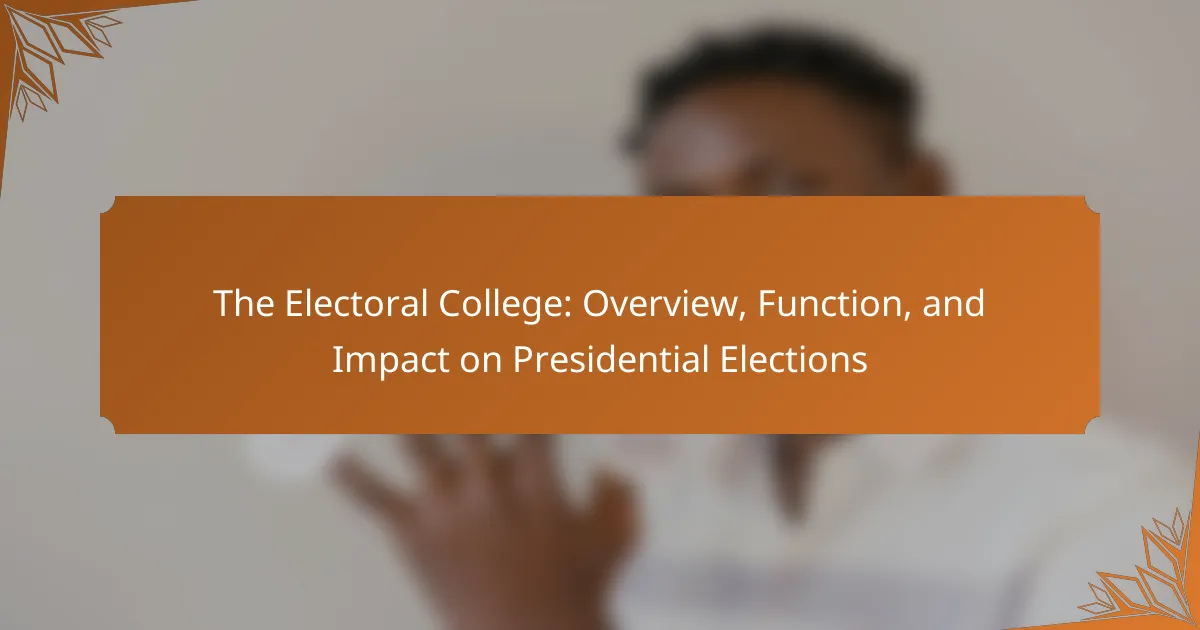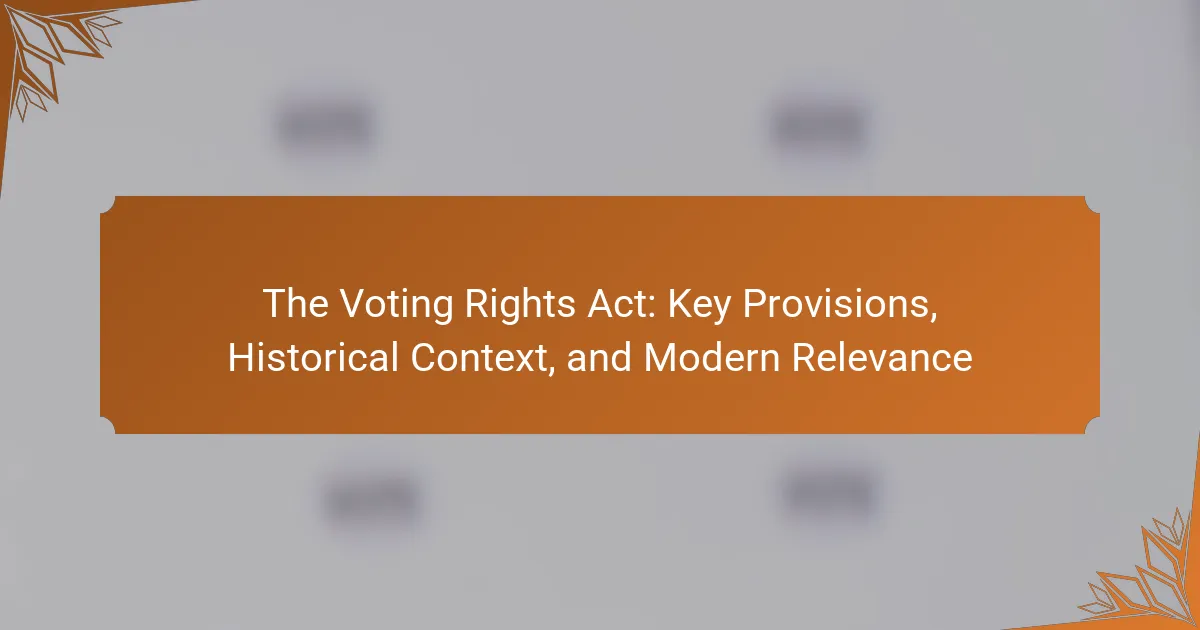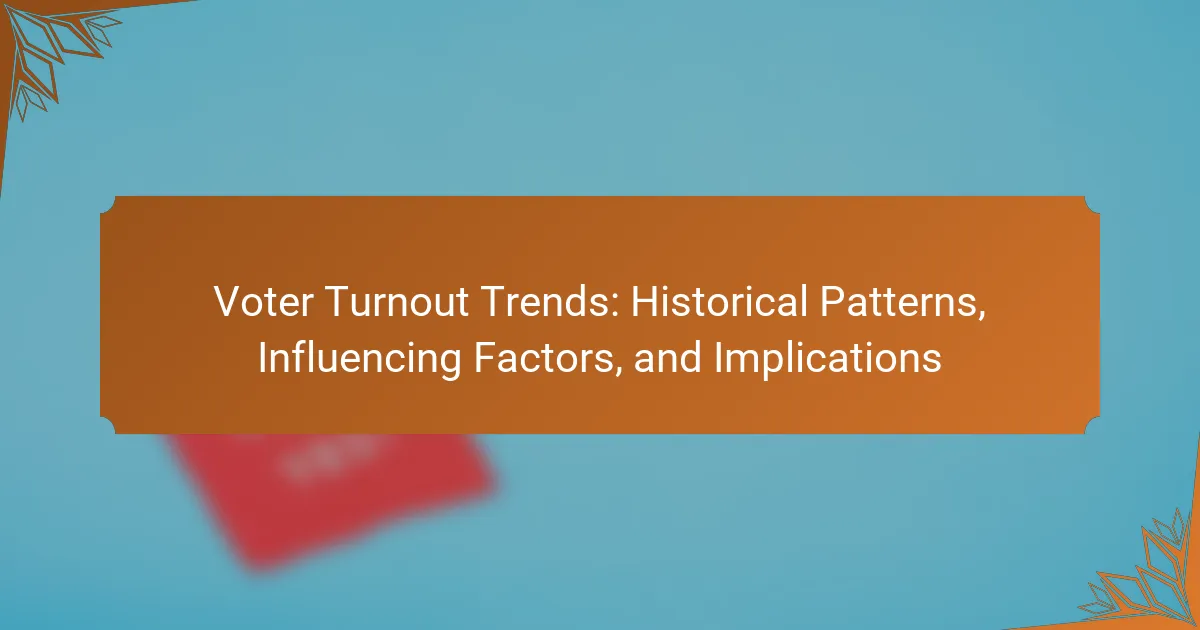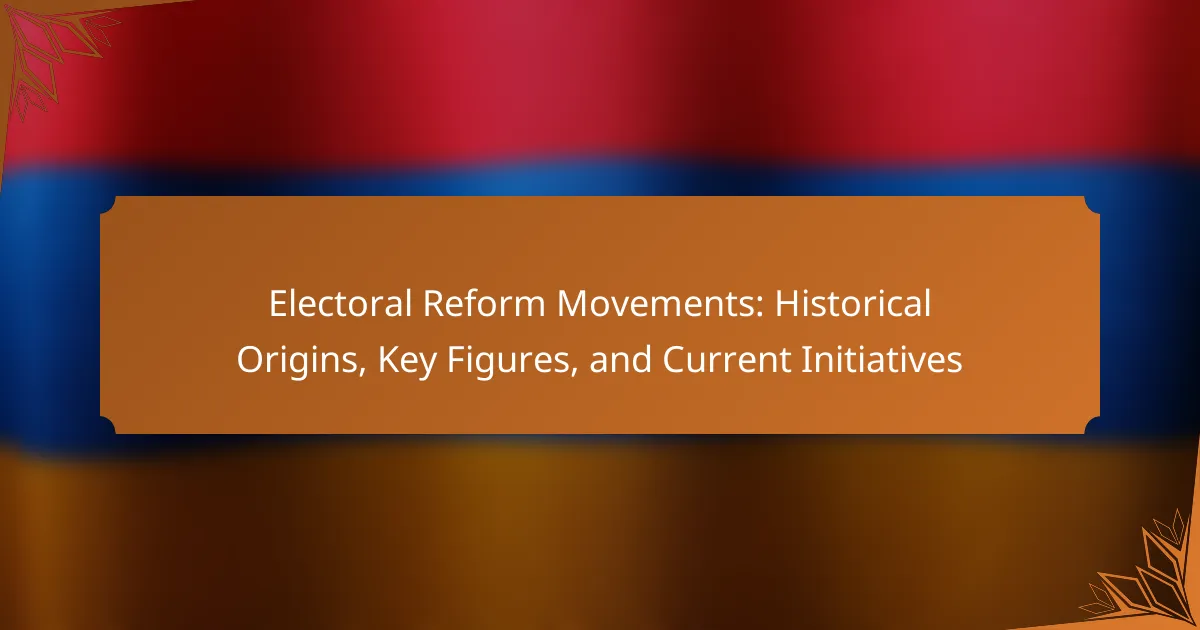The Electoral College is a constitutionally established body responsible for electing the president and vice president of the United States, consisting of 538 electors. Each state’s number of electors corresponds to its congressional representation, with a majority of 270 electoral votes needed to win the presidency. This system influences how votes are converted into electoral votes, often leading candidates to focus on swing states due to the winner-takes-all approach used by most states. The article explores the Electoral College’s function, its impact on presidential campaigns, historical instances of popular vote discrepancies, and ongoing discussions regarding potential reforms to ensure equitable voter representation in future elections.
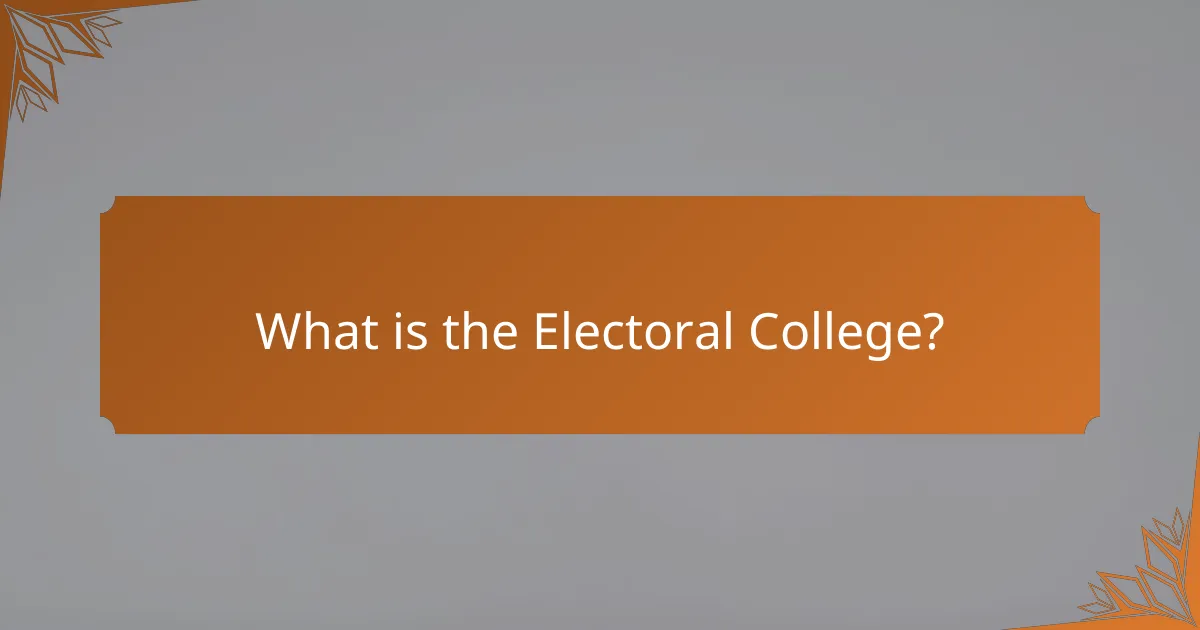
What is the Electoral College?
The Electoral College is a body established by the United States Constitution for the election of the president and vice president. It consists of 538 electors, with each state having a number of electors equal to its total number of senators and representatives in Congress. When citizens cast their votes in a presidential election, they are actually voting for a slate of electors pledged to vote for their chosen candidate. These electors then formally elect the president and vice president in a process that takes place in December following the election. The majority of electoral votes required to win the presidency is 270. The system was created to balance the influence of populous states with less populous ones in presidential elections.
How was the Electoral College established?
The Electoral College was established by the United States Constitution in 1787. It was created as a compromise between electing the president by a vote in Congress and by popular vote. The framers of the Constitution aimed to balance the influence of populous states with less populous ones. Article II, Section 1 of the Constitution outlines the process for electors to be chosen by each state. Each state is allocated electors equal to its total number of senators and representatives in Congress. This system was designed to ensure that all regions of the country have a voice in the election of the president. The first presidential election using the Electoral College occurred in 1789.
What historical context led to the creation of the Electoral College?
The Electoral College was created in the context of the founding of the United States. The framers of the Constitution sought a compromise between electing the president by a vote in Congress and by popular vote. They aimed to balance the influence of populous states with less populous ones. The system was established in 1787 during the Constitutional Convention in Philadelphia. The framers feared direct democracy could lead to mob rule. They designed the Electoral College to ensure informed decision-making by electors. Each state’s electors equal its congressional representation, blending federal and state interests. This compromise reflects the political landscape and concerns of the late 18th century.
What are the constitutional provisions regarding the Electoral College?
The constitutional provisions regarding the Electoral College are outlined in Article II, Section 1 of the U.S. Constitution. This section establishes the framework for the Electoral College system used in presidential elections. It mandates that each state appoint electors equal to its total number of Senators and Representatives in Congress. The electors are responsible for formally electing the President and Vice President. Additionally, the 12th Amendment, ratified in 1804, refined the process by requiring separate votes for President and Vice President. This amendment was introduced to prevent complications that arose in earlier elections. The provisions aim to balance the influence of populous states with less populous ones in the election process.
What is the structure of the Electoral College?
The structure of the Electoral College consists of 538 electors. These electors are appointed by each state based on its congressional representation. Each state has a number of electors equal to its total number of senators and representatives in Congress. The District of Columbia has three electors, as provided by the 23rd Amendment.
Electors are typically chosen by political parties at state conventions. Most states use a winner-takes-all system, where the candidate receiving the majority of votes in that state gets all of its electoral votes. A candidate needs a majority of 270 electoral votes to win the presidency. This structure was established in the U.S. Constitution and has been used since the first presidential election in 1788.
How many electors are there in the Electoral College?
There are 538 electors in the Electoral College. This number is derived from the total of 435 Representatives and 100 Senators in Congress, plus 3 electors from the District of Columbia. The allocation of electors reflects the population of each state, as determined by the census. Each state has a minimum of three electors, regardless of its population. This structure was established by the U.S. Constitution. The Electoral College is responsible for formally electing the President and Vice President of the United States.
What determines the number of electors for each state?
The number of electors for each state is determined by its total number of Senators and Representatives in Congress. Each state has two Senators, which is a fixed number. The number of Representatives varies based on the state’s population, as determined by the decennial census. Therefore, more populous states have more Representatives and, consequently, more electors. For instance, California, with the largest population, has 55 electors, while smaller states like Wyoming have three electors. This system is outlined in the U.S. Constitution, specifically in Article II, Section 1.
What is the function of the Electoral College?
The function of the Electoral College is to formally elect the President and Vice President of the United States. This system allocates electoral votes to each state based on its population and congressional representation. When citizens cast their votes in a presidential election, they are actually voting for a slate of electors pledged to their chosen candidate. These electors then meet in their respective state capitals to cast their votes for President and Vice President. The candidate who receives a majority of the electoral votes, currently set at 270 out of 538, is declared the winner. This process was established in the U.S. Constitution and has been used in every presidential election since 1789.
How does the Electoral College operate during presidential elections?
The Electoral College operates as a mechanism for electing the President and Vice President of the United States. Each state is allocated a number of electors based on its congressional representation. There are a total of 538 electors in the Electoral College. A candidate must receive a majority of 270 electoral votes to win the presidency. During the presidential election, voters cast their ballots for a slate of electors pledged to vote for their chosen candidate. These electors then formally cast their votes in December following the election. The results are certified by Congress in January. This system was established in the U.S. Constitution and has been in place since the first presidential election in 1788.
What are the roles of electors in the Electoral College?
Electors in the Electoral College play a crucial role in the presidential election process. They are responsible for formally casting votes for the president and vice president of the United States. Each state has a designated number of electors based on its congressional representation. For example, California has 55 electors, while Wyoming has 3. Electors are typically chosen by political parties and are expected to vote in line with the popular vote from their state. This process occurs during a meeting of the Electoral College, held in December after the general election. The electors’ votes are then certified and sent to Congress, where they are officially counted in January. This mechanism is outlined in Article II of the U.S. Constitution and was established to balance the influence of populous states with less populous ones in presidential elections.
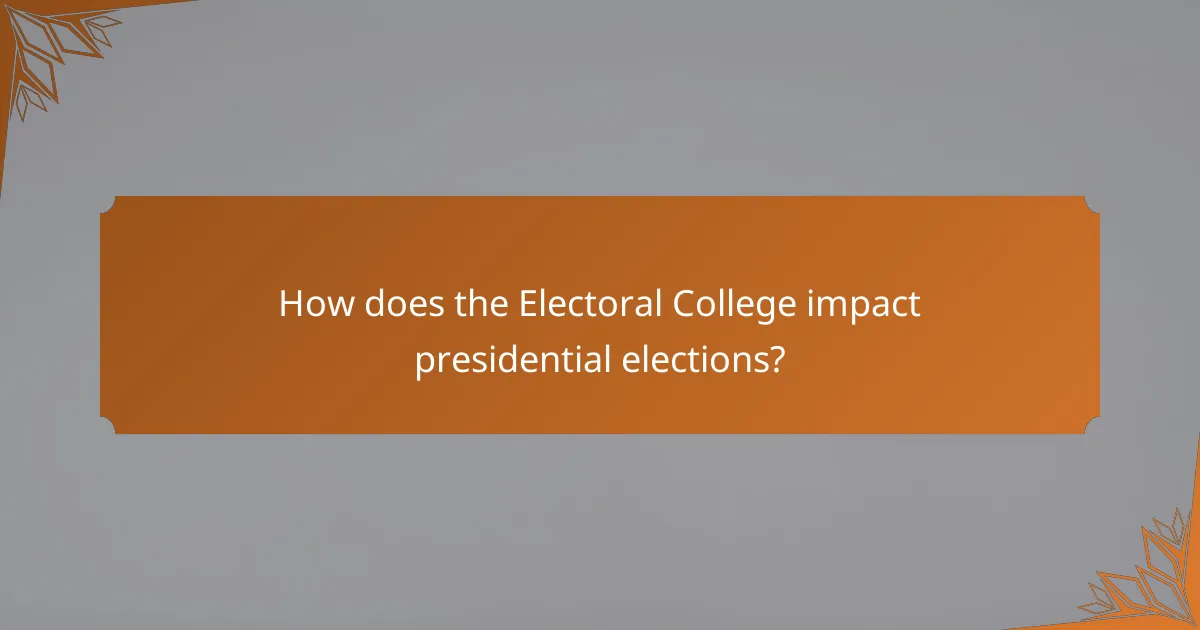
How does the Electoral College impact presidential elections?
The Electoral College impacts presidential elections by determining how votes are translated into electoral votes. Each state is allocated a number of electoral votes based on its congressional representation. A total of 538 electoral votes exist, with 270 needed to win the presidency. Most states use a winner-takes-all system, meaning the candidate with the majority of votes in that state receives all its electoral votes. This system often leads candidates to focus on swing states, where the outcome is uncertain. Historical examples include George W. Bush winning the presidency in 2000 despite losing the popular vote. The Electoral College thus influences campaign strategies and voter turnout across different states.
What are the advantages of the Electoral College system?
The Electoral College system has several advantages. It ensures that all parts of the country have a voice in presidential elections. This system encourages candidates to campaign in a variety of states, not just populous urban areas. It helps to balance the influence of smaller states against larger states. The Electoral College also promotes a two-party system, which can lead to political stability. Additionally, it provides a clear outcome in elections, reducing the likelihood of disputes. Historical context shows that this system has functioned since the founding of the United States. The framers of the Constitution designed it to protect against direct democracy’s potential pitfalls.
How does the Electoral College promote a balance between populous and less populous states?
The Electoral College promotes a balance between populous and less populous states by allocating electoral votes based on a combination of population and equal representation. Each state receives a minimum of three electoral votes, regardless of its population size. This ensures that less populous states have a voice in presidential elections that is not proportionate to their population alone. For example, Wyoming has a smaller population than California but has three electoral votes, giving it a higher per capita electoral influence. This system was designed to prevent populous states from dominating the electoral process. It encourages candidates to campaign in a variety of states, including those with smaller populations. Consequently, the Electoral College fosters a more equitable distribution of political power across the nation.
What are the arguments in favor of maintaining the Electoral College?
The arguments in favor of maintaining the Electoral College include preserving the federal character of the nation. The Electoral College ensures that smaller states have a voice in presidential elections. This system prevents candidates from focusing solely on populous urban areas. It encourages candidates to campaign in diverse regions. The Electoral College promotes a balance of power among states. It also reinforces the importance of state sovereignty in elections. Historical context shows that the Founding Fathers designed this system to balance interests. Maintaining the Electoral College can help uphold this original intent.
What are the criticisms of the Electoral College?
The Electoral College faces several criticisms. One major criticism is that it can lead to a candidate winning the presidency without winning the popular vote. This occurred in the elections of 1824, 1876, 1888, 2000, and 2016. Critics argue that this undermines the principle of one-person, one-vote.
Another criticism is that it disproportionately values votes in smaller states. Each state has a minimum of three electoral votes, regardless of population. This results in a higher voting power for individuals in less populous states compared to those in larger states.
Additionally, the winner-takes-all system used by most states can marginalize third-party candidates. This discourages voter participation for those candidates, limiting the electoral diversity.
Furthermore, the Electoral College can lead to candidates focusing their campaigns on swing states. This neglects voters in states with predictable outcomes, which can create a sense of disenfranchisement.
These criticisms highlight concerns about fairness and representation within the current electoral system.
How does the Electoral College affect voter representation?
The Electoral College affects voter representation by allocating electoral votes based on state populations. Each state receives a number of electoral votes equal to its total congressional representation. This system can lead to unequal representation, as smaller states have a disproportionately higher number of electoral votes per capita. For example, Wyoming has three electoral votes despite a small population, giving its voters more influence than those in larger states like California. Consequently, a candidate can win the presidency without winning the popular vote, as seen in the elections of 1824, 1876, 1888, 2000, and 2016. This mechanism creates a focus on swing states, often neglecting voters in states with predictable outcomes. Thus, the Electoral College can dilute the principle of one-person, one-vote, impacting overall voter representation in presidential elections.
What are the potential consequences of the Electoral College on election outcomes?
The Electoral College can lead to significant discrepancies between the popular vote and the electoral outcome. This system allocates electoral votes based on state populations, which can result in a candidate winning the presidency without winning the nationwide popular vote. For instance, in the 2000 and 2016 elections, the candidates who won the presidency received fewer popular votes than their opponents. This outcome can diminish voter engagement in states deemed as “safe” for one party. Additionally, smaller states have a disproportionately higher influence relative to their population size due to the minimum of three electoral votes per state. Consequently, this can skew campaign strategies, focusing efforts on swing states rather than nationwide voter interests. Such dynamics can lead to a fragmented national political landscape, affecting governance and policy-making.
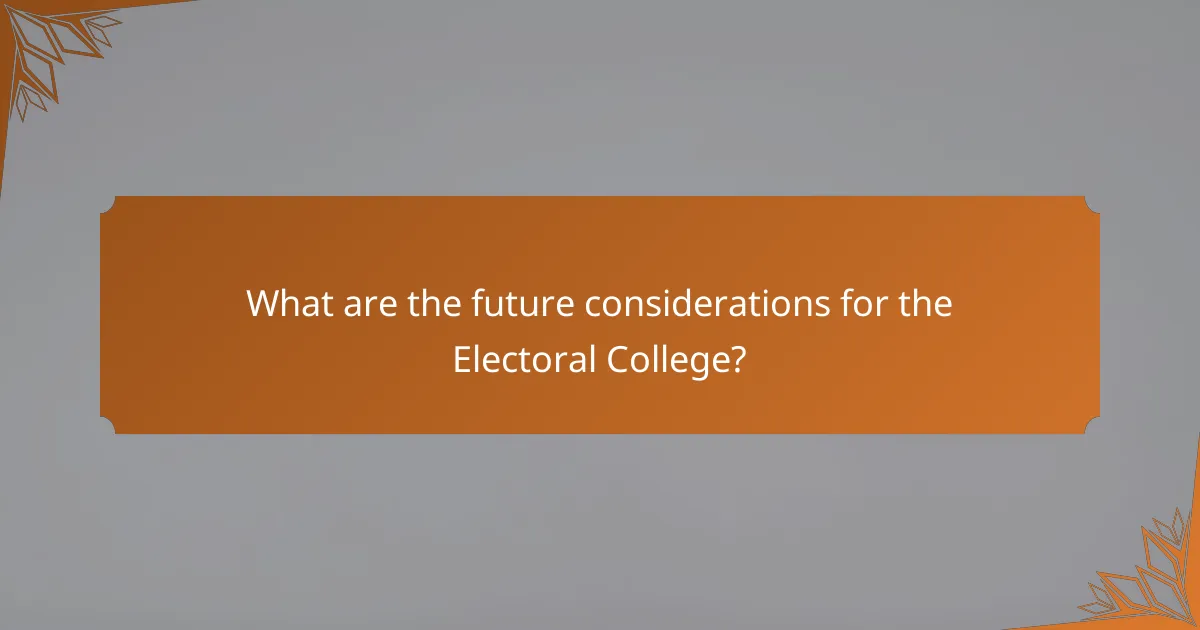
What are the future considerations for the Electoral College?
Future considerations for the Electoral College include potential reforms and public opinion shifts. Many advocate for a national popular vote to replace the current system. This change could ensure that every vote carries equal weight in presidential elections. Additionally, some states have proposed legislation to allocate electoral votes based on the national popular vote. Historical data shows that the Electoral College has led to instances where the popular vote winner did not become president. This has raised questions about its fairness and relevance in modern democracy. As demographics and political attitudes evolve, the debate around the Electoral College is likely to intensify. Changes in voter behavior and engagement may also influence future discussions on this topic.
How might reforms to the Electoral College be proposed?
Reforms to the Electoral College may be proposed through various methods. One method is a constitutional amendment. This requires a two-thirds majority in both the House of Representatives and the Senate. Alternatively, states could adopt the National Popular Vote Interstate Compact. This compact ensures that states award their electoral votes to the candidate who wins the national popular vote. Public advocacy and grassroots movements also play a crucial role in proposing reforms. Historical context shows that past attempts at reform have included proposals for direct popular elections. These proposals often arise from debates about representation and fairness in the electoral process.
What alternative systems have been suggested to replace the Electoral College?
Proportional representation is one alternative system suggested to replace the Electoral College. This system allocates electoral votes based on the percentage of votes received by each candidate. Ranked-choice voting is another proposed alternative. It allows voters to rank candidates in order of preference, ensuring a more representative outcome. National popular vote compact is also suggested. This agreement among states would ensure that the candidate receiving the most votes nationwide wins the presidency. Each of these alternatives aims to enhance voter representation and address concerns about the current system’s fairness.
What are the challenges associated with reforming the Electoral College?
Reforming the Electoral College faces several challenges. One challenge is the requirement for a constitutional amendment. This process requires a two-thirds majority in both houses of Congress and ratification by three-fourths of the states. Achieving this level of consensus is difficult due to political polarization.
Another challenge is the potential resistance from smaller states. The Electoral College gives them a disproportionate influence in elections. Many small states may oppose reforms that could diminish their power.
Public opinion also varies significantly across different demographics. Some voters support reform, while others value the current system. This divergence complicates efforts to build a unified movement for change.
Additionally, there are concerns about the impact of reform on the electoral process. Critics argue that changes could lead to unintended consequences. These could include increased partisanship or voter disenfranchisement.
Overall, the challenges of reforming the Electoral College involve political, structural, and public opinion factors. Each of these elements must be navigated carefully to achieve meaningful change.
What should voters know about the Electoral College?
The Electoral College is a mechanism established by the U.S. Constitution for electing the President and Vice President. Voters should know that it consists of 538 electors. A majority of 270 electoral votes is required to win the presidency. Each state has a number of electors equal to its total number of senators and representatives in Congress. This system means that not all votes carry equal weight, as smaller states have a disproportionately higher number of electors per voter. Voters in most states are bound by winner-take-all rules, meaning the candidate who receives the most votes in a state gets all its electoral votes. This can lead to scenarios where a candidate wins the presidency without winning the popular vote. Understanding the Electoral College is crucial for voters, as it influences campaign strategies and voter turnout across different states.
How can understanding the Electoral College influence voter engagement?
Understanding the Electoral College can significantly influence voter engagement by clarifying how votes translate into electoral outcomes. The Electoral College comprises 538 electors, with a majority of 270 required to win the presidency. This system means that not all votes carry equal weight, particularly in swing states. For instance, voters in California have a lower individual impact compared to voters in battleground states like Florida.
When citizens grasp this concept, they may feel more motivated to participate in elections, especially in states where their votes can sway the outcome. Research shows that voter turnout is higher in competitive states. In the 2020 presidential election, states like Wisconsin and Pennsylvania saw increased voter engagement due to their pivotal roles in determining the winner.
By understanding the mechanics of the Electoral College, voters can make informed decisions about where their efforts are most impactful. This knowledge can lead to higher participation rates and a more engaged electorate.
What resources are available for voters to learn more about the Electoral College?
Voters can access various resources to learn more about the Electoral College. The National Archives and Records Administration provides detailed information on its history and function. Educational websites like Ballotpedia offer comprehensive articles and guides. The U.S. government’s official site also explains the Electoral College process. Additionally, civic organizations often host informational sessions and distribute literature. Scholarly articles and books on American government cover the Electoral College in depth. These resources help voters understand how the Electoral College influences presidential elections.
The Electoral College is a constitutional body established for the election of the President and Vice President of the United States, consisting of 538 electors. Each state’s number of electors is determined by its congressional representation, with a majority of 270 electoral votes needed to win. This article provides an overview of the Electoral College, including its historical context, constitutional provisions, structure, and functions, as well as its impact on presidential elections and voter representation. Additionally, it addresses the advantages and criticisms of the system, potential reforms, and resources for voters to enhance their understanding of the Electoral College.
